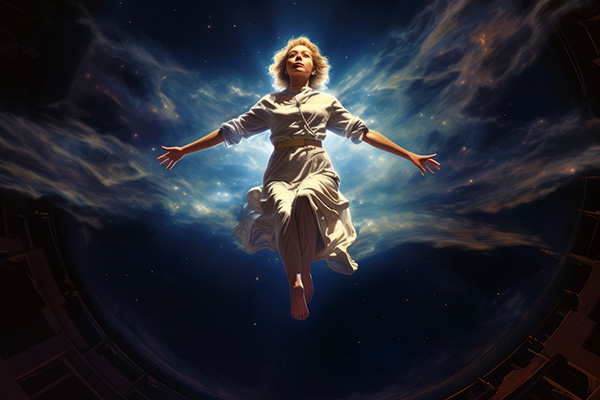out-of-body experience
Why Astral Projection Is A Popular Psychic Practice
 Years ago, my best friend told me that she was having what she described as “floating experiences.” She said that, as she was winding down for the night in bed, she would suddenly feel as though her spirit were drifting above her body. She was really unsettled by this at the time, because she was not trying to make it happen, nor did she feel in control of it.
Years ago, my best friend told me that she was having what she described as “floating experiences.” She said that, as she was winding down for the night in bed, she would suddenly feel as though her spirit were drifting above her body. She was really unsettled by this at the time, because she was not trying to make it happen, nor did she feel in control of it.
At the time, I was deeply involved in psychic development. I spent my evenings buried in books, engaged in discussions, and exploring various spiritual practices.
The moment she described her experiences, I knew exactly what she was talking about. I realized she was describing astral travel. It was nothing new to me, as I had been practicing it myself for quite some time.
Astral travel is the experience of your mental awareness, or your “conscious self,” separating from your physical body and exploring other realms of existence. It’s the experience of your inner being, your soul or spirit, moving beyond the limits of time and space and the restrictions of the material world.
Once you “leave” your physical body, earthly rules no longer apply. Gravity and distance as we know it no longer apply. Some travelers report visiting faraway places on Earth, while others explore entirely different realms or even other planets. For many, this experience proves that we are more than flesh and bone. We are souls with vast potential.
A Beginner’s Guide To Astral Projection
 Every spiritual tradition speaks of a world beyond our own — an ethereal realm that exists just beyond the veil of the physical senses. Whether it’s Nirvana in Buddhism, Asgard in Norse mythology, or the Elysian Fields of the ancient Greeks, these higher dimensions are seen as places of transcendence and divinity.
Every spiritual tradition speaks of a world beyond our own — an ethereal realm that exists just beyond the veil of the physical senses. Whether it’s Nirvana in Buddhism, Asgard in Norse mythology, or the Elysian Fields of the ancient Greeks, these higher dimensions are seen as places of transcendence and divinity.
Traditionally, such realms are associated with the afterlife, but that’s only part of the story. The truth is that we don’t have to die to access them. These higher planes of existence can be explored while we are still very much alive.
While mystics, shamans, and seers have spoken of these realms for millennia, modern science, particularly in the fields of quantum theory and consciousness studies, is beginning to acknowledge the possibility of multiple dimensions, parallel realities, and alternate timelines. Phenomena such as déjà vu or lucid dreaming, for example, may be brief collisions between timelines or conscious overlaps with other dimensions where versions of ourselves already exist.
So how do we consciously access these mystical realms? The practice of astral projection — also known as astral travel, out-of-body experiences, or lucid voyaging — is one way to do just that.
The idea of consciously traveling beyond the physical body has appeared in various cultures and spiritual traditions throughout history. Although interpretations vary, many civilizations have incorporated the concept into their myths, religious practices, and mystical philosophies.
Why You’re Absolutely Meant To Be Here!
 Lately I’ve been hearing more cries for help from clients saying things like: “I really don’t want to be here anymore,” “No one will even miss me when I’m gone,” or “This world is not for me, I never belonged here anyway.”
Lately I’ve been hearing more cries for help from clients saying things like: “I really don’t want to be here anymore,” “No one will even miss me when I’m gone,” or “This world is not for me, I never belonged here anyway.”
This sense of despair seems to have increased in recent times. For many, there seems to be an overwhelming sense that the world is spinning out of control. More and more people are struggling with a deep sense of disconnection and hopelessness, triggered by the relentless pace of global upheaval and chaos.
Some also speak of a deep inner alienation — a quiet pain that comes from trying to reconcile their heartfelt values and dreams with a daily reality that feels cold, uncertain, cruel, and fragmented. They no longer see the compassion, unity, or progress they once believed in, and this leaves them questioning their place in the world, or if they even belong here.
It is a powerful reminder of the urgent need for the world’s lightworkers to rise — to hold space, to nurture hope, to foster connection, and to work toward a more compassionate and sustainable future.
I, for one, do not share this negative view regarding my place and purpose in this world, because about three decades ago I faced a serious illness that nearly ended my life. This traumatic chapter led me to a profound realization: we plan our lives before we incarnate, and we all absolutely belong here!
Paranormal, Or Perinormal?
 When we hear the word “paranormal,” we often think of ghosts, psychic abilities, or UFO sightings. But what does the term really mean?
When we hear the word “paranormal,” we often think of ghosts, psychic abilities, or UFO sightings. But what does the term really mean?
Many of us have had moments that feel mysterious or beyond our understanding — experiences that challenge the way we see the world. What’s interesting is that these experiences aren’t always “paranormal” in the traditional sense — they may actually be “perinormal.”
Understanding the difference between these two ideas can help us see our everyday experiences in a new light, making it easier to connect with the mystical side of life without feeling overwhelmed by the unknown.
“The word “paranormal” comes from the Greek word “para,” which means “outside” or “beyond” normal. It refers to things that are beyond the limits of what we can scientifically measure or explain.
Paranormal experiences, such as ghost sightings or psychic phenomena, defy logic and leave a lasting impact on those who experience them. They’re those mystical or supernatural experiences that break the rules of reality and are completely “outside of normal.”
“Perinormal, on the other hand, comes from the word “peri,” meaning “around” or “near.”. These experiences are on the edge of “normal” — they’re those things we sense, feel, or observe that are related to subtle, measurable energies or natural laws, but also remain mysterious and unexplained.
Perinormal experiences show us that the spiritual and mystical are often much closer to reality than we realize – they just exist in a space we do not yet fully understand, or perhaps never will?


